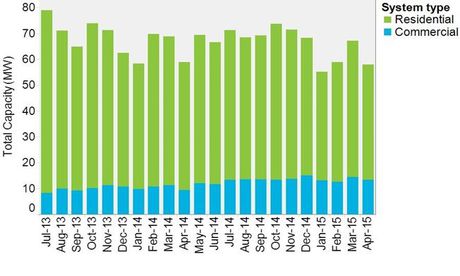Australian solar PV market contracts

The Australian PV market contracted 6.5% in four months to April 2015 compared to the same period last year, according to Ric Brazzale, managing director of Green Energy Trading. Total PV installations dropped to 182,500 in 2014 as against 359,566 in 2011.
The number of residential installations is expected to decline as saturation increases, Brazzale said, noting that the residential market has already fallen by 13%. Queensland and South Australia are experiencing high levels of saturation. As against this, commercial (10-100 kW) and large-scale installations (>100 kW) are growing. Commercial solar PV grew by 30% in four months to April 2015, compared to the same period last year. The small-scale market seems to be stabilising at around 800 MW a year, Brazzale said. Businesses in New South Wales are leading the charge into commercial solar PV.
The data from Green Energy Markets shows that NSW retained its position as the biggest market for solar PV in the month of March, following its return to that position in February for the first time since 2011. Queensland led the market in between and retains the largest aggregate installations. In the month of March, NSW installed 19.4 MW of rooftop solar, beating Queensland (18 MW) for the second month in a row, with Victoria coming a close third with 16.3 MW. Both Western Australia and South Australia are heading for a total of 80 to 90 MW for the calendar year, continuing their high rate of rooftop solar penetration.
Solar may have had a slow start in 2015, but Andrew Blakers, director of the Australian National University Centre for Sustainable Energy Systems, believes renewables are well on track to push fossil fuels and nuclear out of the picture within the next 10-15 years. Australia could achieve 100% renewables by 2040 by adding 1.9 GW/year of solar PV capacity and 1.9 GW/year of wind power capacity, said Blakers. With wind power (at 7-12 c/kWh) and solar PV (at 9-14 c/kWh) now costing the same as new-build coal and gas (7-12 c/kWh) power stations, there are no more economic constraints, Blakers said. He said Australia would reach 90% renewables by 2040 through natural attrition of fossil fuel power stations. The global PV shipments are growing at the rate of 15% a year, according to him. Meanwhile, cell efficiency is expected to improve by 20-26% by 2025 and module price is expected to fall to US$0.40/W.
South Australia and Tasmania have already achieved 40% (wind and PV) and 100% (hydro and wind) renewables respectively, and ACT is targeting 90% renewables by 2020, according to Blakers.
Queensland is targeting 50% renewables by 2030. Queensland’s Minister for Energy and Water Supply Mark Bailey told Solar 2015 that his government wants to see one million Queensland rooftops fitted with solar panels by 2020, as part of its Solar Future program. “Getting these projects built is crucial to Labor’s vision of a 50% renewable energy target by 2030,” Bailey said. His government had a vision to see projects of the future become a reality - like the Mount Emerald Wind Farm and Solar Choice’s Darling Downs solar farm, he added.
2025 saw record EV sales in Australia
More than 157,000 electric vehicles were sold in the nation last year, accounting for 13% of all...
2025–26 GenCost report released for public consultation
Solar PV and onshore wind still form the basis for Australia's cheapest electricity...
ARENA invests $21m in three EV charging projects
Funded under the Driving the Nation Program, the projects will focus on developing pathways and...



